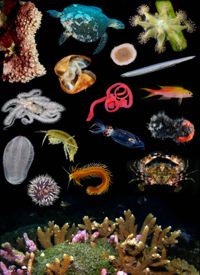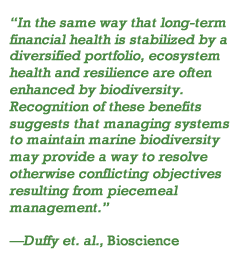Experts call for network to monitor marine biodiversity
Observations could warn of threats to ecosystems on which humans depend
Humans tend to monitor what they think is important—blood pressure, batting averages, hurricane tracks, Internet bandwidth, voting results, and stock prices, among other phenomena.
But, say a team of ocean experts, sometimes we don’t know what’s important until it’s too late, and that ignorance can come back to bite us. Their article in the new issue of BioScience calls for establishment of a national network to monitor the diversity of marine life, a key bellwether of ocean and human health.

The article’s lead author, Professor J. Emmett Duffy of the Virginia Institute of Marine Science, says, “We depend on ocean life for food, livelihoods, and half the oxygen we breathe—no matter how far inland we live. We know the ocean is sick and getting sicker but we don’t even have a finger on the pulse, so to speak, so we’re not sure how bad it is or how to cure it. Our paper offers a plan for regular check-ups to keep sea life healthy”
A comprehensive marine biodiversity observation network could be established with modest funding within five years, say Duffy and his co-authors—from the Marine Biological Laboratory in Woods Hole, Massachusetts, the University of Kansas, the Florida Museum of Natural History, the University of Rhode Island’s Graduate School of Oceanography, the Woods Hole Oceanographic Institution, and the University of California Davis.
To be most effective, the authors say, such a network would monitor biodiversity at all biological levels, from microscopic genes to regional ecosystems. It would also link observations of biodiversity to the physical factors controlling sea life such as water temperature and water quality, and be flexible enough to detect and track emerging issues as environmental conditions change.
The authors also stress that an observing network for marine biodiversity should be “designed by nature, not people.” Says Duffy, “The location of the network’s individual sites should be based on where organisms live, and on factors like water temperature and currents, rather than on political boundaries. That will ensure that insights into biodiversity change and its causes are environmentally relevant.”
They envision a network with sites along both the East and West coasts of the United States, with other nodes focusing on the deep sea and coral reefs. A U.S. network would complement regional efforts already underway in the European Union, New Zealand, and elsewhere, and could incorporate technology and lessons learned from existing “ocean observing systems” that focus on measurements of physical factors such as water temperature, wave height, current speed and direction, salinity, and oxygen levels.
The technology for a marine biodiversity observation network already exists in the form of high-tech gear such as AUVs (autonomous underwater vehicles), ROVs (remotely operated vehicles), ocean drifters, and monitoring buoys. These would complement and extend ship- and shore-based research efforts, both by academic researchers and a cadre of citizen scientists.
 “Developing human resources is as important as technical innovation in creating a successful network,” the authors write. “To maximize participation and accessibility, [the network] should . . . result in products that are widely usable. Creative use of citizen science could also broaden support, engage the public, and reduce costs.” Collected data—whether from new observations or historical research—would be made readily accessible online, allowing for analysis of current conditions and long-term trends.
“Developing human resources is as important as technical innovation in creating a successful network,” the authors write. “To maximize participation and accessibility, [the network] should . . . result in products that are widely usable. Creative use of citizen science could also broaden support, engage the public, and reduce costs.” Collected data—whether from new observations or historical research—would be made readily accessible online, allowing for analysis of current conditions and long-term trends.
“A comprehensive network to monitor marine biodiversity is not pie in the sky—or sea,” says Duffy. “We can start right now by building on existing infrastructure, networks, and technology, and then gradually expand. We already have the technology; the challenges are to coordinate existing efforts into a proactive and flexible approach of adaptive monitoring. That will save money, and potentially property and lives, by anticipating hazards resulting from a changing ocean.”

